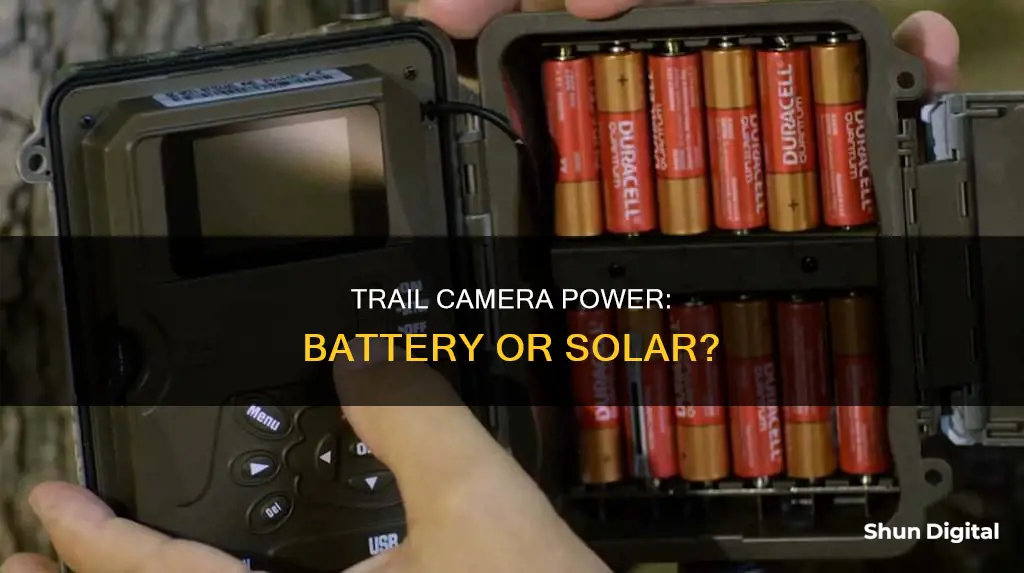
Trail cameras are typically powered by batteries, with most using AA or D-cell batteries, and some models using rechargeable lithium-ion batteries. The battery life of a trail camera varies depending on the model, settings, usage, and environmental factors. On average, trail cameras can capture 5,000 to 30,000 photos on a full charge, lasting anywhere from 7 to 12 months. Factors affecting battery life include shooting video, using rechargeable batteries, temperature, night shooting, trigger delay, and the number of transmissions.
| Characteristics | Values |
|---|---|
| Power Source | Batteries, solar panels |
| Battery Type | AA, D-cell, lithium-ion, alkaline, NiMH, lithium |
| Battery Life | Several months to a few weeks |
| Battery Management | Disposable, rechargeable |
| Solar-Powered Trail Cameras | Environmentally friendly, cost-effective, less reliable in limited sunlight |
What You'll Learn

Trail cameras typically use AA or D-cell batteries
AA batteries are the most common type used in trail cameras. Within this type of battery, there are several options to choose from, each with its own advantages and disadvantages. Alkaline batteries, for example, are widely available and inexpensive, but they have several drawbacks. They start with a power level of about 1.5 volts, but this decreases over time and with use. They are also affected by cold temperatures, losing up to half their capacity in freezing weather. Additionally, they are prone to leaking acid and are not environmentally friendly as they are usually single-use. Lithium batteries, on the other hand, offer a stronger power output of 1.6 volts/cell and are unaffected by temperature changes. They last longer than alkaline batteries and are lighter in weight. However, they are more expensive and have recently been found to include a higher number of bad cells.
Rechargeable batteries are another option for trail cameras, with nickel-metal hydride (NiMH) and lithium-ion (Li-ion) being the two main types. NiMH batteries are less expensive in the long run and have a longer battery life during the winter months, but they are adversely affected by hot weather. They also have a lower voltage than alkaline batteries, which can make them incompatible with some trail camera models. Li-ion batteries, on the other hand, have a high energy density, long cycle life, low self-discharge, and no memory effect. However, they are harder to calculate the remaining capacity for and are more expensive.
In recent years, there has been a growing trend towards using solar-powered trail cameras, which can be more environmentally friendly and cost-effective in the long run. Solar panels convert sunlight into electrical energy to power the camera, eliminating the need for batteries. However, they may not be suitable for all environments, especially those with limited sunlight or extreme weather conditions.
Charging Your Polaroid Z2300: A Quick Guide
You may want to see also

Rechargeable lithium-ion batteries are also used in some models
Rechargeable lithium-ion batteries are another option for powering some trail camera models. These batteries have several advantages over other types of batteries.
Firstly, they have a high energy density, meaning they can store a significant amount of energy in a small volume, making them ideal for trail cameras where space and weight are concerns. They also have a long cycle life, with the ability to be charged and discharged for hundreds to thousands of cycles before their capacity significantly diminishes.
Another benefit of lithium-ion batteries is their low self-discharge rate. They lose their charge relatively slowly when not in use, which is not the case with some other rechargeable batteries. Additionally, they do not suffer from the "memory effect" seen in older nickel-cadmium batteries, where full discharge cycles are required to maintain capacity.
Lithium-ion batteries provide a consistent voltage of 3.7 volts. However, to make them compatible with devices that use standard AA batteries, some manufacturers include a microprocessor on the tip of the battery that regulates the voltage to exactly 1.5 volts. This ensures that the battery is compatible with a wider range of devices.
While lithium-ion batteries offer many advantages, they also have some drawbacks. One disadvantage is the difficulty in calculating their remaining capacity. Since they produce a constant 1.5 volts throughout their lifecycle and then die abruptly, trail camera users must manually keep track of the number of photos taken to estimate the battery life.
Another disadvantage is the cost. Lithium-ion batteries are more expensive than some other battery types due to advanced manufacturing processes. However, the additional expense is usually offset after just a few charges, making subsequent use almost free.
Overall, while rechargeable lithium-ion batteries may require a little more attention, they provide consistent and reliable power for trail cameras. Despite the initial expense, they can be a cost-effective and environmentally friendly choice in the long run.
Charging Your Camera in Europe: What You Need to Know
You may want to see also

Solar panels can be used to power trail cameras
Solar panels contain photovoltaic (PV) cells, or solar cells, which present a photovoltaic effect that allows them to absorb photons within light and release electrons. These electrons are then captured, stored, and used as an electrical current. This electrical current is direct current (DC), the same type of power source that runs trail cameras, so an inverter is not needed.
Each solar panel is different, but most store the electrical current within an internal battery enclosed in the solar panel. This allows the solar panel to store energy and have a reserve of electricity during nighttime hours. Once charged, installing a solar panel to a trail camera is easy. Simply use the power cord from the solar panel and plug it into the auxiliary port (AUX) at the bottom of your trail camera.
It is recommended to still install the camera's recommended batteries as a backup in case the solar panel is unable to produce enough energy. This is especially important if there is a wave of nighttime activity around the trail camera that drains the stored energy from the solar panel.
When using a solar panel, it is important to be aware of the amount of voltage your trail camera requires. Most cameras on the market today use 12-volt systems, but there has been an influx of cameras that require only 6-volt systems. Solar panels come in a variety of voltage applications, so it is crucial to check the trail camera's owner's manual to ensure compatibility.
The most common use of solar panels is in conjunction with wireless cameras (cellular, wifi, or Bluetooth). Cellular cameras have a much shorter battery life than standalone trail cameras due to the amount of network searching and photo uploads required. A solar panel can provide virtually unlimited battery life for cellular cameras, allowing users to access the needed information without having to physically go to the camera location.
There are many options on the market for solar panels, including brand-specific panels that are designed for certain trail cameras, as well as aftermarket solar panels that can be used with various camera models.
LG X Camera Specs: X Charge Edition
You may want to see also

Battery life varies depending on the model and usage
The battery life of trail cameras varies depending on the model and usage. The number of pictures taken, the percentage of day-to-night photos, temperature, and power consumption characteristics unique to each camera all influence how long a trail camera's batteries will last.
Some trail cameras can shoot up to 20,000 photos on a set of batteries, with a battery life of 8-12 months. However, this can range from 5,000 to 30,000 photos on a full charge. The type of battery also makes a difference. Lithium batteries, for example, last about three times longer than alkaline batteries and are more resistant to cold temperatures. On the other hand, alkaline batteries are cheaper and more readily available.
The settings on your trail camera can also impact battery life. For instance, video mode will drain the battery much faster than photo mode. Additionally, features like time-lapse and multi-shot will decrease battery life. Other factors that affect battery life include trigger delay, resolution, and night mode.
To extend the battery life of your trail camera, consider using higher-quality batteries, such as lithium, and avoid rechargeable batteries. Adjust your camera settings to take lower-resolution photos and increase the trigger delay in areas with higher animal traffic. Also, try to avoid placing the camera in extreme temperatures, especially cold, as this can drain the batteries.
External power sources, such as solar panels and battery boxes, can also be used to increase the battery life of your trail camera. Solar panels, for example, can provide a continuous source of energy for your camera if they receive enough direct sunlight. Battery boxes, on the other hand, provide a simple solution by allowing you to plug your camera into a rechargeable 12V battery.
Camera Battery Grips: Are They Worth the Hype?
You may want to see also

Cold temperatures can reduce battery life
Cold temperatures can significantly reduce battery life. This is due to the chemical reactions required to generate energy becoming slower and less efficient. This results in a decrease in the capacity and discharge rate of the battery. Additionally, the battery becomes less mechanically stable, and charging it can cause further damage.
The impact of cold on battery life is influenced by the type of battery. Lithium batteries, for example, are less affected by freezing temperatures compared to alkaline batteries. However, even lithium batteries can experience a reduction in performance in cold weather. The optimal temperature range for lithium batteries is -4°F to 140°F, but they should only be charged in temperatures between 32°F and 131°F (0°C to 55°C) for maximum safety. Charging lithium batteries below freezing can cause permanent damage.
The impact of cold temperatures on battery life is also influenced by the specific camera model and its settings. Cameras with wireless technologies, such as cellular modems, consume more power than cameras that simply take photos. Additionally, settings such as mode, detection delay, multi-shot, and resolution can affect battery life.
To mitigate the effects of cold temperatures on battery life, there are several solutions. One option is to use a battery blanket or a battery box to insulate the battery and protect it from the cold. Another option is to use solar panels to charge the batteries before heading out in the cold. Keeping the battery in a heated area, such as a garage, can also help. Additionally, some batteries have self-heating functions that can be activated in cold weather.
In summary, cold temperatures can have a significant impact on battery life, but there are ways to mitigate this impact and ensure that your trail camera batteries last as long as possible.
Charging Muvi Cameras: A Quick Guide to Powering Up
You may want to see also
Frequently asked questions
Trail cameras typically use AA or D-cell batteries, but some models may use rechargeable lithium-ion batteries.
The battery life of a trail camera depends on various factors, such as the model, usage, and temperature. They can last for several months on a single set of batteries, but this may vary.
Yes, some trail cameras can be powered by external power sources such as solar panels or external battery packs, which can extend their battery life.
Rechargeable batteries are cost-effective and environmentally friendly, but they may not be compatible with all trail camera models and can have shorter battery lives in certain conditions.
To maximise battery life, use high-quality batteries and adjust camera settings to conserve power. This includes reducing the number of photos taken per trigger, using a lower flash setting, and adjusting the camera's sensitivity to motion.







